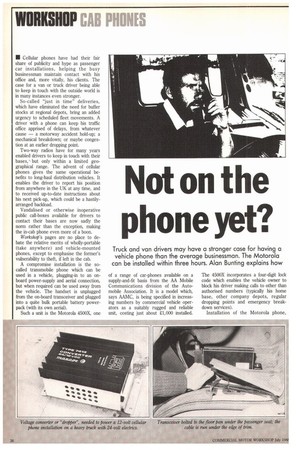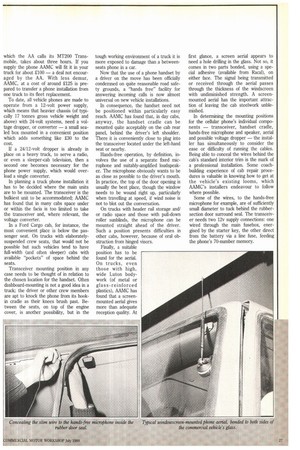Not on the phone yet?
Page 132

Page 133

If you've noticed an error in this article please click here to report it so we can fix it.
• Cellular phones have had their fair share of publicity and hype as passenger car installations, helping the busy businessman maintain contact with his office and, more vitally, his clients. The case for a van or truck driver being able to keep in touch with the outside world is in many instances even stronger.
So-called "just in time" deliveries, which have eliminated the need for buffer stocks at regional depots, bring an added urgency to scheduled fleet movements. A driver with a phone can keep his traffic office apprised of delays, from whatever cause — a motorway accident hold-up; a mechanical breakdown; or maybe congestion at an earlier dropping point.
Two-way radios have for many years enabled drivers to keep in touch with their bases, but only within a limited geographical range. The advent of cellular phones gives the same operational benefits to long-haul distribution vehicles. It enables the driver to report his position from anywhere in the UK at any time, and to received up-to-date instructions about his next pick-up, which could be a hastilyarranged backload.
Vandalised or otherwise inoperative public call-boxes available for drivers to contact their bases are now sadly the norm rather than the exception, making the in-cab phone even more of a boon.
Workshop's pages are no place to debate the relative merits of wholly-portable (take anywhere) and vehicle-mounted phones, except to emphasise the former's vulnerability to theft, if left in the cab.
A compromise installation is the socalled transmobile phone which can be used in a vehicle, plugging-in to an onboard power-supply and aerial connection, but when required can be used away from the vehicle. The handset is unplugged from the on-board transceiver and plugged into a quite bulk portable battery powerpack (with its own aerial).
Such a unit is the Motorola 4500X, one of a range of car-phones available on a supply-and-fit basis from the AA Mobile Communications division of the Automobile Association. It is a model which, says AAMC, is being specified in increasing numbers by commercial vehicle operators as a suitably rugged and reliable unit, costing just about 21,000 installed. The 4500X incorporates a four-digit lock code which enables the vehicle owner to block his driver making calls to other than authorised numbers (typically his home base, other company depots, regular dropping points and emergency breakdown services).
Installation of the Motorola phone, which the AA calls its MT200 Transmobile, takes about three hours. If you supply the phone AA/AC will fit it in your truck for about £100 — a deal not encouraged by the AA. With less demur, AAMC, at a cost of around £125 is prepared to transfer a phone installation from one truck to its fleet replacement.
To date, all vehicle phones are made to operate from a 12-volt power supply, which means that heavier chassis (of typically 17 tonnes gross vehicle weight and above) with 24-volt systems, need a voltage dropper, or converter — a small sealed box mounted in a convenient position which adds something like £30 to the cost.
If a 24/12-volt dropper is already in place on a heavy truck, to serve a radio, or even a sleeper-cab television, then a second one becomes necessary for the phone power supply, which would overload a single converter.
In planning a truck phone installation it has to be decided where the main units are to be mounted. The transceiver is the bulkiest unit to be accommodated; AAMC has found that in many cabs space under or within the facia is too limited to take the transceiver and, where relevant, the voltage converter.
In a Ford Cargo cab, for instance, the most convenient place is below the passenger seat. On trucks with elaboratelysuspended crew seats, that would not be possible but such vehicles tend to have full-width (and often sleeper) cabs with available "pockets" of space behind the seats.
Transceiver mounting position in any case needs to be thought of in relation to the chosen location for the handset, Often dashboard-mounting is not a good idea in a truck; the driver or other crew members are apt to knock the phone from its hookin cradle as their knees brush past. Between the seats, on top of the engine cover, is another possibility, but in the tough working environment of a truck it is more exposed to damage than .a betweenseats phone in a car.
Now that the use of a phone handset by a driver on the move has been officially condemned on quite reasonable road safety grounds, a "hands free" facility for answering incoming calls is now almost universal on new vehicle installations.
In consequence, the handset need not be positioned within particularly easy reach. AAMC has found that, in day cabs, anyway, the handset cradle can be mounted quite acceptably on the cab rear panel, behind the driver's left shoulder. There it is conveniently close to plug into the transceiver located under the left-hand seat or nearby.
Hands-free operation, by definition, involves the use of a separate fixed microphone and suitably-amplified loudspeaker. The microphone obviously wants to be as close as possible to the driver's mouth. In practice, the top of the door opening is usually the best place, though the window needs to be wound right up, particularly when travelling at speed, if wind noise is not to blot out the conversation.
On trucks with header rail storage and/ or radio space and those with pull-down roller sunblinds, the microphone can be mounted straight ahead of the driver. Such a position presents difficulties in other cabs, however, because of oral obstruction from hinged visors.
Finally, a suitable position has to be found for the aerial. On trucks, even those with high, wide Luton bodywork (of metal or glass-reinforced plastics), AAMC has found that a screenmounted aerial gives more than adequate reception quality. At first glance, a screen aerial appears to need a hole drilling in the glass. Not so, it comes in two parts bonded, using a special adhesive (available from Racal), on either face. The signal being transmitted or received through the aerial passes through the thickness of the windscreen with undiminished strength. A screenmounted aerial has the important attraction of leaving the cab steelwork unblemished.
In determining the mounting positions for the cellular phone's individual components — transceiver, handset cradle, hands-free microphone and speaker, aerial and possible voltage dropper — the installer has simultaneously to consider the ease or difficulty of running the cables. Being able to conceal the wires behind the cab's standard interior trim is the mark of a professional installation. Some coachbuilding experience of cab repair procedures is valuable in knowing how to get at the vehicle's existing looms, which AAMC's installers endeavour to follow where possible.
Some of the wires, to the hands-free microphone for example, are of sufficiently small diameter to tuck behind the rubbersection door surround seal. The transceiver needs two 12v supply connections: one wired through the main fusebox, energised by the starter key, the other direct from the battery via a line fuse, feeding the phone's 70-number memory.
















































































































































